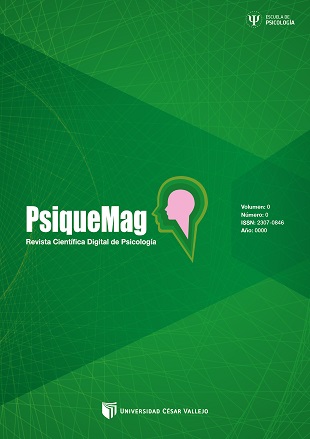Neuropsychological study of temperament and its relationship with relationship with associated attention disorders in 7- and 8-year-old children
Keywords:
system, affective-emotional component, temperament, attention deficitAbstract
The aim of the present investigation is to identify the mechanisms of deformation of the affective - emotive system and his relation with the disorders of attention in children between the ages from 6 to 7 years of age, the instruments used were SNT designed by Sarria 2010 and Faces Test: Yale, 2006, and the protocol of evaluation of control of the healthy child registered by the specialists pediatricians of HNERM at different stages of the children. The method used was descriptive correlational of the affective - emotive system and his relation with the disorders of attention. He arrived at the following conclusions: 1.The mother child interaction in the first stage of life has significant influence on the formation of emotional affective system and this determined a posteriori indices of attention deficit. 2. There is a direct correlation between positive emotional development and optimal level of selective attention. 3. There is a direct correlation between unfavorable emotional development and deficient level of selective attention.
References
Díaz, M. (2009). Curso Taller Avanzado. Técnicas y métodos de Investigación Científica. Lima: Manual UPCH.
García, P., Llaja, V., Sarria, C., (2009). Aptitudes cognitivas y estrategias de memorización secuencial de los alumnos de un Centro Educativo privado de Comas. Lima: Revista de Investigación en Psicología. Instituto de Investigaciones Psicológicas de la UNMSM,Vol 12, (1), pp. 45- 59.
Hernández, R., Fernández, C., & Baptista, M. (2013). Metodología de la Investigación. México: Mc Graw Hill.
Ison, M., & Anta, F. G. (2006). Estudio normativo del Test de Percepción de diferencias (caras) en niños Mendocinos Leído el 24 de Enero del 2012 en https://www.scielo.org.ar/Scielo.php?Script=Sciarttext&piod=S1668. Versión Online ISSN 1668-7027.
Luria , A. R. (1974). "Cerebro en Acción”. Barcelona: Fontanella.
Llaja, V., Sarria, C., García, P. (2009). Evaluación neuropsicológica del delirio y la Incidencia de los factores de riesgo en pacientes de Cuidados Intensivos del HNERM. Lima: Revista Médica Rebagliati. Año 1. Vol. 4, pp. 32-36.
Llaja, V, Sarria, C., García, P. (2008). Déficit cognitivos en la enfermedad de Parkinson interpretados bajo el modelo informacional de la Personalidad. Lima: Revista de la Academia Peruana de Neurociencias del Perú. Año 1. No. 1 Vol. 1, pp. 25-28.
Ortiz, P. (2008). Educación y formación de la personalidad. Lima: Fondo Editorial de la Universidad de Ciencias y Humanidades.
Ortiz, C. P. (2004). Cuadernos de Psicobiología Social 1 Introducción a la Psicobiología del hombre. Lima: Talleres Gráficos. U.N.M.S.M.
Ortiz, C. P. (2004). Cuadernos de Psicobiología Social 6 El nivel Consciente de la Actividad Personal. Lima: talleres Gráficos. U.N.M.S.M.
Ortiz, C.P. (1998). El Nivel Consciente de la Memoria. Fondo Editorial de la Universidad de Lima. Lima.
Ortiz, P. (1997). La formación de la Personalidad. Lima: Dimaso Editores.
Ortiz, P. (1994). El Sistema de la Personalidad. Lima: Talleres Gráficos. U.N.M.S.M.
Reynolds, C. R., & Hickman, J. A. (2004). Draw- A-Person Intellectual Ability Test for Children, Adolescents, and Adults (DAP:IQ). Austin: PRO-ED.
Lindgren, S. D., & Richman, L. D. (1984). Inmediate memory functions verbally deficient reading-disabled children. Journal of Learning Disabilities, 17, 222-225.
Richman, L. C., & Lindgren, S. D. (1980). Patterns of intellectual ability in children with verbal deficits. Journal of Abnormal Child Psichology, 8, 65-75.
Rourke, B. P. (Ed.) (1985). Neuropsychology of learning disabilities. New York: GuilfordPress.
Sarria, C., García, P., & Llaja, V. (2008). Compendio de Neuropsicología clínica Pesquisas Neuropsicológicas. Lima: CEPREDIM.UNMSM.
Sarria, C., García, P., & Llaja, V. (2008). Test de Percepción Visomotor de Benton Revisado. Lima: CEPREDIM.UNMSM.
Downloads
Published
How to Cite
Issue
Section
License
Copyright (c) 2015 PsiqueMag

This work is licensed under a Creative Commons Attribution-NonCommercial-NoDerivatives 4.0 International License.
You are free to:
- Share — copy and redistribute the material in any medium or format
- The licensor cannot revoke these freedoms as long as you follow the license terms.
Under the following terms:
-
Attribution — You must give appropriate credit, provide a link to the license, and indicate if changes were made. You may do so in any reasonable manner, but not in any way that suggests the licensor endorses you or your use.












